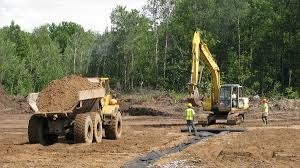The Connection Between Landscaping Work and Sitework in Construction
In the construction industry, every stage of a project plays an important role in shaping the final outcome. For contractors and material suppliers across the United States, understanding how different scopes of work connect is key to successful project delivery. One of the most overlooked relationships in the construction process is the strong link between landscaping work and sitework.
While they may seem like separate activities, landscaping and sitework are closely tied together in both planning and execution. Together, they ensure that a project’s exterior environment is not only functional but also visually appealing and sustainable.
What Is Sitework?
Before a building takes shape, sitework prepares the ground for construction. It includes grading, excavation, drainage, utilities, paving, and sometimes retaining structures. Sitework is the foundation of every project — it ensures the land is stable, level, and ready for vertical construction.
This phase often involves heavy machinery, survey data, and precision calculations to achieve the required elevations and slopes. Without proper sitework, even the most beautiful structure can face issues like poor drainage, erosion, or uneven settlement.
What Is Landscaping Work?
Landscaping, on the other hand, focuses on the appearance, usability, and environmental health of the finished site. It includes planting trees and shrubs, laying sod, installing irrigation systems, building pathways, and placing decorative features like rocks or lighting.
In commercial and residential developments alike, landscaping adds the finishing touch that enhances property value and creates a welcoming environment. But landscaping is more than just aesthetics — it supports erosion control, temperature regulation, and stormwater management when designed correctly.
How Landscaping and Sitework Connect
The connection between sitework and landscaping is deeper than most realize. In fact, successful landscaping depends heavily on how sitework is planned and executed.
For example, proper grading and drainage design during sitework determine how surface water will move across the land. If grading is not accurate, landscaped areas may flood, plants could die, and retaining walls might fail. Similarly, the soil prepared during sitework directly affects plant growth and irrigation efficiency.
When contractors and landscape teams coordinate early in the design phase, they can prevent costly issues later. For instance, the placement of underground utilities, storm drains, and irrigation lines can be planned together to avoid conflicts once the landscaping phase begins.
The Role of Estimating in Linking Both Scopes
Accurate cost estimation is the bridge between sitework and landscaping. Estimators who understand both scopes can identify overlaps and optimize material quantities. This is where landscaping estimating services play a vital role for contractors and developers.
Professional estimators analyze drawings to calculate quantities for soil, gravel, topsoil, sod, plants, and irrigation components. They also consider labor, equipment, and time needed to execute the landscaping portion effectively.
By combining this with data from the sitework estimate, contractors can create more accurate project budgets and schedules. This prevents surprises later in the project and ensures that both site and landscaping elements complement each other perfectly.
Why Accurate Landscaping Estimates Matter
For general contractors, earthwork contractors, and material suppliers, having precise landscaping estimates means better cost control and smoother coordination.
- Budget Control: Knowing the quantity of materials such as mulch, sod, or aggregate prevents over-ordering or shortages.
- Scheduling Efficiency: When estimators align landscaping quantities with sitework progress, materials can be delivered just in time — saving space and storage costs.
- Profit Protection: With the support of expert landscape estimating services, contractors can bid confidently, reduce waste, and avoid rework caused by poor planning.
In competitive U.S. markets, small details often decide who wins a bid. Accurate landscaping and sitework coordination not only reduce costs but also build a reputation for professionalism and reliability.
Environmental and Design Benefits
The connection between these two scopes also benefits the environment. When grading and drainage plans work hand-in-hand with landscape design, the site can naturally handle stormwater through bioswales, rain gardens, or vegetated buffers.
This integration helps projects meet environmental regulations and achieve sustainability goals. Developers in many states now prefer such designs because they reduce maintenance costs and improve long-term site performance.
Collaboration Is Key
Strong communication between the sitework contractor, landscape designer, and estimator is essential. A clear understanding of grades, soil types, and material placement ensures that each trade’s work supports the other.
For instance, if a sitework contractor knows the exact finish grade required for a landscaped lawn or a parking island, they can complete the grading more precisely. Likewise, landscapers can plan irrigation and planting layouts with confidence when they know the subgrade elevations are correct.
Conclusion
Landscaping and sitework are not separate worlds — they are two parts of the same system that shapes every construction project. From grading to planting, both must work together to create a functional and beautiful environment.
Using professional landscaping estimating services helps bridge these scopes through accurate planning, cost control, and better communication. Contractors and suppliers who understand this link gain a competitive advantage, reduce risks, and deliver higher-quality results.
In the fast-paced U.S. construction industry, success often comes from those who look beyond the surface — and recognize how every layer of the project connects to the next.
